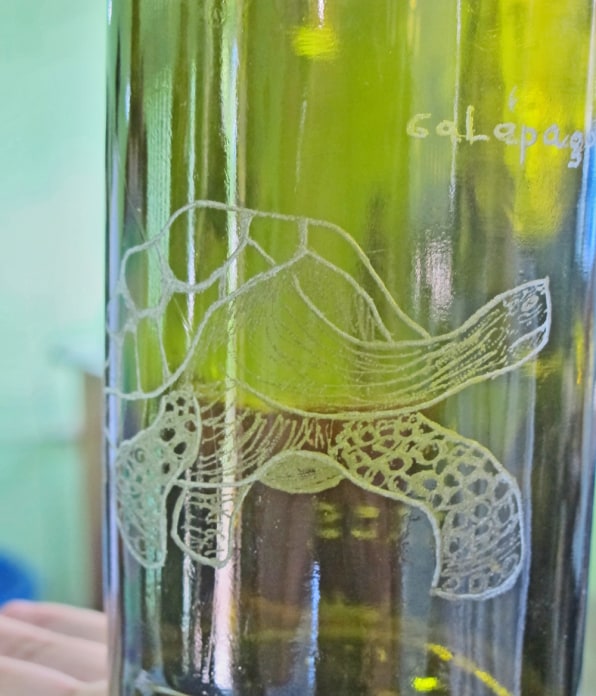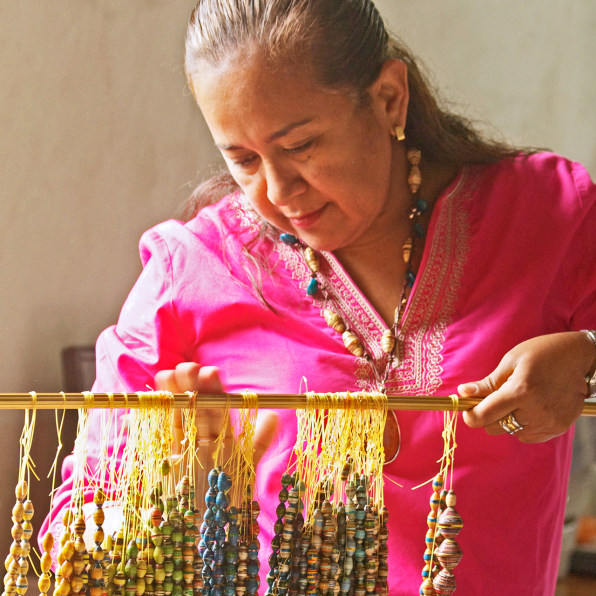New York Artist Turns Junk Into Art John and Ruby
The Galapagos may be known, rightfully, for its striking array of wild fauna establish nowhere else in the earth. And, to be sure, you won't see a blue-footed booby or a ruby-red-throated frigate anywhere but hither. Only the "Enchanted Islands," as Charles Darwin dubbed the isolated archipelago 600 miles from the coast of Ecuador, are also abode to another rare sight: an abundance of fine art fabricated from trash.
Walk into a store on Puerto Ayora, the bustling port town on the isle of Santa Cruz, and yous'll run into all manner of beautiful glassware, paper beaded necklaces, bracelets, and earrings made by local artisans. And all fashioned from mounds of recycled paper and drinking glass, collected from islanders and tourists alike.

The idea to turn trash into fine art evolved three years ago, when Lindblad Expeditions launched a program in the Galapagos called the Lindblad National Geographic Artisan Fund. After anchoring in the pristine islands for decades, the travel visitor wanted to solve 2 interrelated issues: reduce the amount of trash and help artists and craftspeople make a living from tourism. Considering nigh of the Galapagos is protected national parkland, recycling was already required by law. Just many artisans relied on materials shipped from Republic of ecuador, which is extremely expensive.
In April 2011, Lindblad teamed with Paper to Pearls, a microenterprise project for disadvantaged women, and brought Sarah Akot, a Ugandan paper beadmaker, to the Galapagos. As the caput of a women'due south beading cooperative in a refugee military camp, Akot had never left northern Uganda, much less traipsed across the seas to a chain of volcanic islands straddling the Equator. Afterwards she arrived, she called a friend to study that the ocean was not only bigger than Republic of uganda, just Africa, too.
Akot spent three days each on Santa Cruz and Isabela islands, teaching locals the art of paper beadmaking and assembling jewelry. Many of the community women were married to fishermen, and wanted to help support their families. Although the charismatic Ugandan teacher spoke English, most of her students didn't. So preparation manuals were created in Castilian. The Artisan Fund also provided bundles of paper–calendars, magazines, posters from Lindblad's armada of ships–for rolling the beads. Using newspaper, pair of scissors, rulers and glue, Akot showed them how to turn the beads into an item of high-quality jewelry. By the finish of the workshop, the students had a piece of handmade jewelry to take home. But more than than that, they'd experienced a cross-cultural exchange spanning art, conservation, and commerce. On Akot's last day, the students gave her gifts, and she danced to a CD of traditional northern Ugandan music.
They never saw their mentor again. In early 2013, Akot died of unknown causes in a hospital in Uganda. Yet, her legacy in Galapagos lives on. You can find recycled paper jewelry in most sixty% of the shops on Santa Cruz and Isabela. More than a dozen local women are making an income selling their jewelry, including at two galleries devoted to recycled handcrafts and art on Lindblad's ships. Last year the Endeavor, Islander and the Explorer generated $xvi,000 in sales of paper jewelry from travelers–a percentage of which is recycled into the Artisan Fund for artists.
The recycling projection has also grown. Last year, renowned Hudson Valley glassblower John Gilvey taught islanders how to make objects using recycled glass, and New York artist Jennifer Rutheny did a series of metal jewelry workshops in the Galapagos.
Last winter, I visited a few of the artisans at their studios in Puerto Ayora. Sara Fiallos, a 51-year-one-time beader, works out of her cheerful stucco dwelling house in a large, blusterous space that spans the kitchen and living room. Her jewelry is sold on Lindblad's ships. On a table were bowls of beads and tidily arranged necklaces in unmarried colors like heaven blue. They looked as shiny equally porcelain. Fiallos likes monochromatic designs because she thinks they're more elegant. There were likewise chaplet in plastic numberless, carefully sorted by color and size. On some other tabular array were supplies: nails, toothpicks, posters, and long strips of paper for making the "pearls." As we talked in Spanish, her husband Ricardo sat at a calculator while a small white fluffy canis familiaris padded almost on the white tile.

Dressed in a hot pink blouse and blue slacks, her sleek black pilus pulled back with a aureate clip, the tranquility artisan said it usually takes her virtually a week to terminate a piece of jewelry. Once she chooses the design and the colors, she rolls the cut newspaper triangles into beads, slathers them with varnish, and then hangs the jewelry on a wooden rod outside to dry. 2 young women help her ringlet the paper chaplet. She loves the process so much she taught a friend to bead.
Daysi Patino'south "studio" was a tiny cinderblock room off an aisle in town. It was stacked floor to ceiling with shelves, old travel catalogs ("New Expeditions for 2013"), dozens of baby jars bursting with beads, empty milk cartons, and cardboard boxes filled with magazines. A Trader Joe's handbag sat on the floor. Patino, a confident woman of 47 with black frizzy hair, had on jeans, an aqua T-shirt, and tennis shoes. Her playful, multi-colored jewelry adorned her arms and neck.
Patino sells her work non only through Lindblad, but in a half dozen shops on Puerto Ayora and San Cristobal. Although she had an office job with the Tourist Ministry, she took the jewelry and glass workshops considering she wanted to work for herself. She already made plastic beaded necklaces, so paper beading was easy. She earns at least $400 a calendar month and says her bracelets sell the best. She fondly remembers the Ugandan adult female–who "came from a state then far away"–to teach her and other people in the Galapagos a valuable trade. Akot's story of being a refugee and how beading had helped her survive deeply resonated. "She translated how important it was to her," said Patino. "She was a natural teacher."
Source: https://www.fastcompany.com/3032652/how-a-ugandan-refugee-helped-turn-trash-in-the-galapagos-into-art
0 Response to "New York Artist Turns Junk Into Art John and Ruby"
Post a Comment